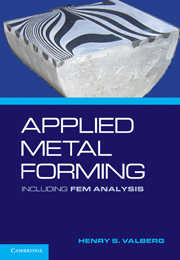Book contents
- Frontmatter
- Contents
- Preface
- APPLIED METAL FORMING
- 1 Characteristics of Metal Forming
- 2 Important Metal Forming Processes
- 3 FEA of Metal Forming
- 4 Theory
- 5 Reduction and Proportions of the Plastic Zone
- 6 Deformations from the Velocity Field
- 7 Technological Tests and Physical Simulation
- 8 Flow Stress Data
- 9 Formability and Workability
- 10 Friction and Friction Models
- 11 Thermal Effects
- 12 Experimental Metal Flow Analysis
- 13 Theoretical Methods of Analysis
- 14 Finite Element Analysis
- 15 FEA of Technological Tests
- 16 Forging
- 17 FEA of Forging
- 18 Extrusion
- 19 FEA of Extrusion
- 20 Rolling
- 21 FEA of Rolling
- 22 Drawing of Wire, Profiles, and Tubes
- 23 FEA of Wiredrawing
- 24 Sheet-Metal Forming
- Index
- References
21 - FEA of Rolling
Published online by Cambridge University Press: 05 June 2012
- Frontmatter
- Contents
- Preface
- APPLIED METAL FORMING
- 1 Characteristics of Metal Forming
- 2 Important Metal Forming Processes
- 3 FEA of Metal Forming
- 4 Theory
- 5 Reduction and Proportions of the Plastic Zone
- 6 Deformations from the Velocity Field
- 7 Technological Tests and Physical Simulation
- 8 Flow Stress Data
- 9 Formability and Workability
- 10 Friction and Friction Models
- 11 Thermal Effects
- 12 Experimental Metal Flow Analysis
- 13 Theoretical Methods of Analysis
- 14 Finite Element Analysis
- 15 FEA of Technological Tests
- 16 Forging
- 17 FEA of Forging
- 18 Extrusion
- 19 FEA of Extrusion
- 20 Rolling
- 21 FEA of Rolling
- 22 Drawing of Wire, Profiles, and Tubes
- 23 FEA of Wiredrawing
- 24 Sheet-Metal Forming
- Index
- References
Summary
Three different cases of metal rolling will be analyzed in this chapter by use of FEA. The simulation results obtained in each case will be examined in order to describe the mechanics of these typical industrial rolling situations. It will be shown that the deformation process is indeed very different in slab rolling from what it is in strip rolling because of the use of very different thickness-to-width ratios of material in the roll gap. In addition, the effect of the use of a light pass in the slab rolling process is considered. The main rolling parameters used in the three different cases of rolling analyzed here are specified in Table 21.1. The obtained results reveal clearly that the mechanics of rolling are complex. The deformation distribution obtained in the roll gap is found to depend strongly on the parameter Δ (see eq. 5-13), as well as on the reduction taken in the rolling step. Note that, in this chapter, slab rolling is considered as a hot rolling process applied to the alloy AA 3003. Strip rolling, on the other hand, is considered as cold rolling process for an alloy with a flow stress described by σ = 180ε0.1. In all cases considered here, plane strain FEM models are used to model the rolling process.
Hot Rolling of an Aluminum Slab in a Light Pass
To analyze the mechanics of deformation when utilizing a very light rolling pass, the upper half of the FEM model shown in Fig. 21.1 was made.
- Type
- Chapter
- Information
- Applied Metal FormingIncluding FEM Analysis, pp. 376 - 394Publisher: Cambridge University PressPrint publication year: 2010



